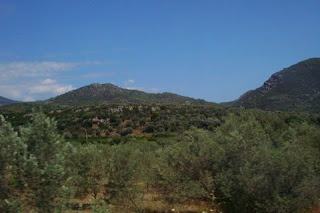Over the years I've attended several dramas at the Epidauros ancient theatre, but had never investigated the Asklepeion healing sanctuary there. I've also been to Corinth a couple of times, but had never returned to Mycenae to see those massive cyclopean walls, the Lion Gate and the Royal tombs. This bus tour seemed the best option for me and the thought of riding in an air conditioned bus was appealing.
The route took us on the coastal road, past the fabled site of the Eleusinian Mysteries and across the Corinthian Canal which connects the Aegean Sea with the Ionian Sea. Once you get beyond the industrial zone past Piraeus, the scenery is spectacular. The Corinth Canal provides a short cut and safe passage connecting the two seas and dates back to Roman times when the first excavations began, forging a way through where boats would be hauled from one side to the other of the narrow isthmus. With better technology the canal was finally opened in 1893, and is similar to the Suez Canal.
Epidauros theatre
Asklepeion
Our first stop on the tour was the Sanctuary of Asklepeion, the healing shrine at Epidauros, which traditionally included a theatre, part of the ancients psycho-therapy. The sanctuary was dedicated to Asklepios,the legendary son of Apollo. These shrines were always near natural springs and in settings that were inspirational for the well-being of people who visited. There was a gymnasium, stadium for games and a theatre where festivals and dramas were held. The theatre of Epidauros seated 14,000 people and was found almost intact in its beautiful setting amid trees, with a backdrop of rolling hills. The acoustics of the theatre is nearly perfect because of the extraordinary way it was constructed. Even today the actors do not use mikes to project their voices.The Asklepeion sanctuary which is part of the site, contains many ruins of the buildings such as a 'hospital' for the ill, a 'hotel' for visitors, dwellings for priests/physicians and a spa. It is in a setting of pine trees in a valley, a tranquil setting to aid in the healing of those who came for treatment.
The Bourzi at Nauplion
Nauplion: Palimidi FortressThe tour bus left Epidauros headed toward Nauplion and stopped for a photo shoot of the picturesque town nestled by the sea below the importing ramparts the Palamidi Fortress. On the way, we passed by the archaeological site of Tiryns, a Mycenaean fortress featured in Homeric epic poems and stories related to Theseus. I definitely plant a trip to explore this 3,000 year old site further on my next visit.
Nauplion: Palimidi FortressThe tour bus left Epidauros headed toward Nauplion and stopped for a photo shoot of the picturesque town nestled by the sea below the importing ramparts the Palamidi Fortress. On the way, we passed by the archaeological site of Tiryns, a Mycenaean fortress featured in Homeric epic poems and stories related to Theseus. I definitely plant a trip to explore this 3,000 year old site further on my next visit.
Tiryns
After stopping for an excellent lunch, we finally arrived at Mycenae. The acropolis and palace of Mycenae is the citadel of Agamemnon, the king who led the Greeks in the Trojan Wars along with his brother Menelaus who was king of Sparta. The site was uncovered in 1874 by German archaeologist Heinrich Schliemann (who also excavated Troy) as he set out to prove the factual basis of Homer's epithets of "well built Mycenae, rich in gold". Unfortunately he also plundered these sites and removed a lot of artifacts. This site is famous in the Greek tragedies, as after his return from Troy, Agamemnon was murdered by his wife, Clytemnestra and her lover who later were murdered by their daughter Electra and son Orestes. This fulfilled a curse on the House of Atreus.imposed on Agamemnon at the onset of the Troy Wars.Lion Gate
The citadel is imposing, especially the gigantic stone walls and the famous Lion Gate where you enter the site. There are a number of impressive ruins including a circle grave and the palace itself high on the crest of the hill. Further down the hill is another huge domed grave or 'treasury' site where royalty was apparently buried. Schliemann had identified the tombs of Clytemnestra and her lover Agesthies and of the "Treasury of Atreus" named the Tomb of Agamemnon, however it is now concluded that although these maybe royal tombs they were from a different period. The big 'treasury' bomb is an impressive monument which is entered thru a 15 metre corridor into a beehive-like structure built without use of mortar. The great lintel of the doorway is formed of immense stones estimated to weigh 118 tonnes.

When we left Mycenae we stopped by a pottery workshop. This huge shop makes and distributes the museum copy artifacts that you find in souvenier shops around Greece. It was interesting to watch the potter and pottery painter at work and to see the thousands of pieces they have produced in this family-operated shop.
The Potter at work
The Painter at work
Pottery before it's painted
For me, the day trip in a comfortable air condition environment with a well-informed tour guide was worth the price (99Euro) and I even got a student discount, thanks to my friend Carol!


















No comments:
Post a Comment